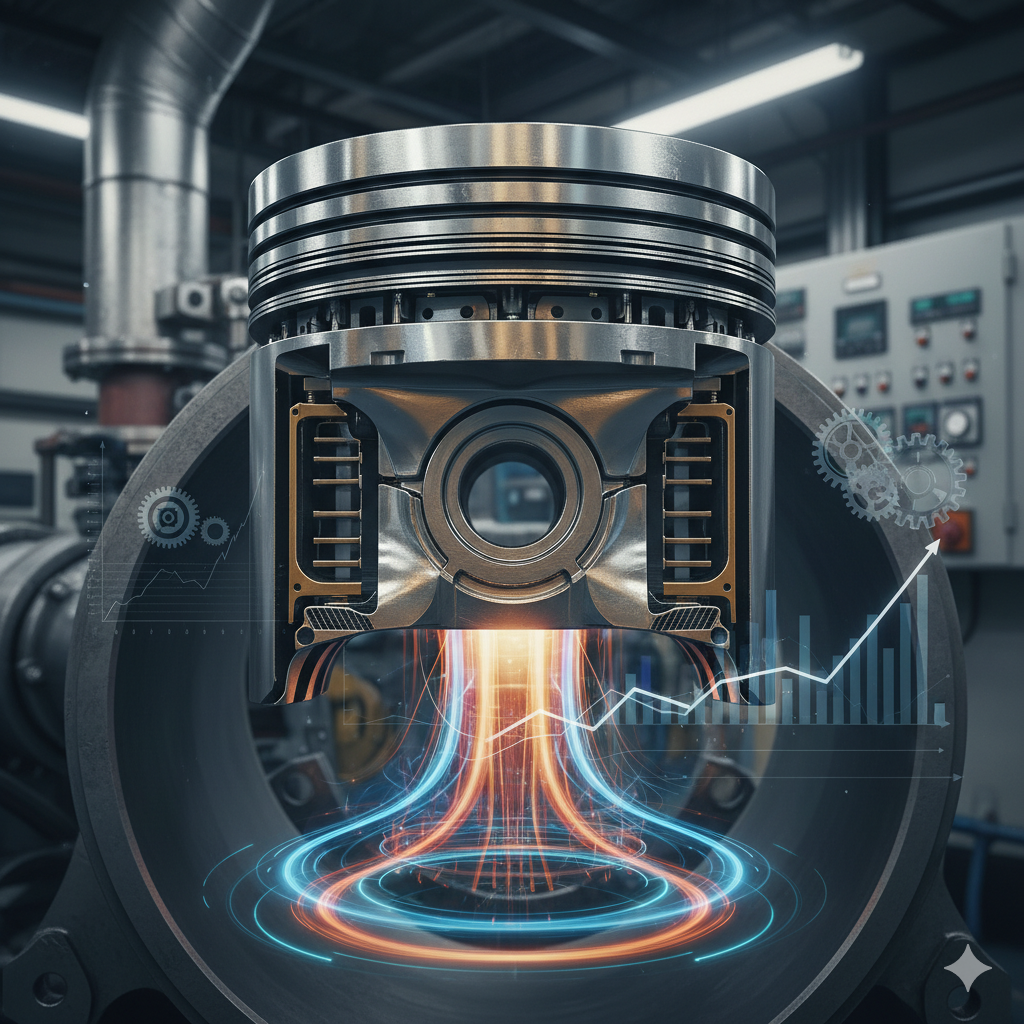The Critical Role of the Piston Crown in Enhancing Marine Engine Efficiency

In the world of marine engineering, efficiency isn’t just a goal—it’s a necessity. Every component within a marine engine contributes to the vessel’s performance, fuel economy, and reliability. Among these components, the piston crown stands out as one of the most critical elements influencing combustion efficiency and power output.
Marine engines operate in harsh environments for long hours, demanding resilience and precision from every moving part. The piston crown, being at the heart of the combustion process, endures intense heat and pressure. Understanding its function, maintenance, and impact on performance is essential for shipowners, engineers, and operators aiming to maximize engine efficiency and longevity.
What Is a Piston Crown and Why It Matters
The piston crown is the upper surface of the piston that comes directly into contact with the high-temperature gases produced during combustion. It plays a crucial role in:
-
Compressing the air-fuel mixture inside the combustion chamber.
-
Shaping combustion for efficient energy conversion.
-
Transferring heat from the combustion zone to the cooling system.
-
Withstanding mechanical stress during power strokes.
Because it operates under extreme thermal and mechanical loads, the piston crown’s design and condition have a direct impact on how effectively the engine burns fuel and generates power.
You can learn more about high-quality marine-grade piston crowns at RMS Marine Service Company, a trusted supplier known for providing durable and OEM-standard components for the marine industry.
How the Piston Crown Affects Marine Engine Efficiency
1. Optimized Combustion for Maximum Power
The shape of the piston crown influences how air and fuel mix within the combustion chamber. Modern marine engines often feature bowl-shaped or re-entrant crowns that promote efficient air swirl and turbulence. This ensures uniform fuel burning, leading to higher thermal efficiency and lower emissions.
If the piston crown surface becomes carbonized, worn, or deformed, the air-fuel mixture burns unevenly—causing incomplete combustion, reduced power, and increased fuel consumption.
2. Heat Transfer and Thermal Balance
During combustion, temperatures in the cylinder can exceed 2,000°C. The piston crown must absorb and transfer this heat through the piston body and into the cooling system without distortion.
Poor heat transfer or carbon buildup on the crown’s surface can trap excessive heat, leading to thermal cracking, detonation, and even engine failure. Maintaining a clean and undamaged piston crown ensures stable combustion temperatures and longer engine life.
3. Reduced Emissions and Cleaner Operation
The design and condition of the piston crown directly affect how completely the fuel burns. Efficient combustion minimizes the release of unburned hydrocarbons and soot. When combined with a properly tuned fuel injection system, a clean piston crown helps the engine meet IMO (International Maritime Organization) emission standards while maintaining optimal performance.
4. Improved Fuel Economy
Fuel is one of the highest operational costs for shipping companies. A well-maintained piston crown ensures that every drop of fuel is used effectively. Efficient combustion means more power output per unit of fuel, resulting in lower operational costs and a reduced environmental footprint.
Common Problems Affecting Piston Crowns
Even though piston crowns are made from high-strength materials such as forged steel or aluminum alloys, they are not immune to wear and damage. Common issues include:
-
Carbon Deposits: Build up due to incomplete combustion, restricting airflow and heat dissipation.
-
Thermal Cracks: Result from uneven heating or cooling, often caused by poor lubrication or coolant flow.
-
Erosion and Pitting: Caused by poor-quality fuel, high combustion pressure, or injector malfunction.
-
Crown Deformation: Occurs when the piston crown overheats and expands beyond tolerance limits.
Routine inspection and cleaning are essential to detect and address these issues early before they cause significant engine damage.
Best Practices for Maintaining Piston Crowns
To ensure consistent engine performance and longevity, marine engineers should follow a proactive maintenance schedule focusing on the piston crown and related components.
1. Regular Inspections
During scheduled maintenance or overhauls, inspect piston crowns for cracks, pitting, or carbon buildup. Using a borescope allows engineers to examine the crown without full engine disassembly.
2. Proper Lubrication
Use high-quality marine-grade lubricants to prevent metal-to-metal contact and control heat generation during combustion.
3. Maintain Fuel Injection Systems
Faulty injectors can cause uneven fuel spray, resulting in hot spots on the piston crown. Regular calibration ensures uniform fuel distribution.
4. Cooling System Efficiency
Ensure proper cooling water and oil circulation to avoid overheating. Check for scale or blockage in cooling passages.
5. Use Genuine Replacement Parts
When piston crowns or related components need replacement, always choose genuine OEM-standard parts. Trusted suppliers like RMS Marine Service Company provide marine piston crowns built to withstand extreme conditions and enhance performance reliability.
The Role of Trusted Suppliers in Marine Engine Efficiency
A marine engine’s efficiency depends not only on proper maintenance but also on the quality of the parts used. Substandard or non-OEM piston crowns can lead to misalignment, premature wear, or combustion inefficiency.
Partnering with reliable suppliers like RMS Marine Service Company ensures that shipowners and operators receive components that meet stringent international quality standards. RMS offers a full range of marine engine parts, including piston crowns, repair kits, and fuel injection systems, helping fleets operate with confidence and consistency.
Conclusion
The piston crown may appear as a small component within a massive marine engine, but its role is far from minor. It governs combustion quality, power output, fuel efficiency, and emission levels—all critical factors for successful marine operations.
Regular inspection, proper maintenance, and the use of high-quality replacement parts are essential to maintaining your vessel’s performance and reliability.
By investing in genuine piston crown components from RMS Marine Service Company, shipowners can ensure smoother voyages, lower maintenance costs, and improved engine efficiency for years to come.
- Art
- Causes
- Crafts
- Dance
- Drinks
- Film
- Fitness
- Food
- Jogos
- Gardening
- Health
- Início
- Literature
- Music
- Networking
- Outro
- Party
- Religion
- Shopping
- Sports
- Theater
- Wellness




